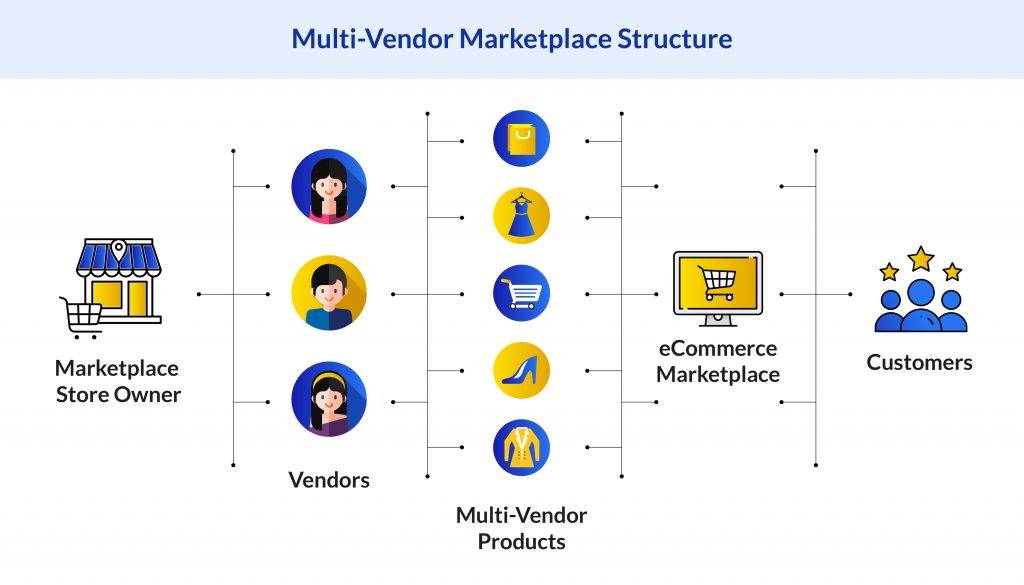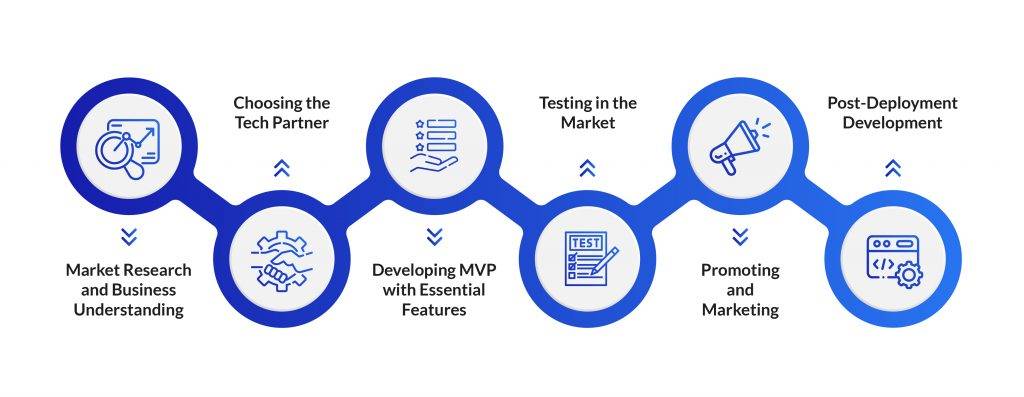As a retailer looking to start a multi-vendor marketplace, you are often driven by ideas regarding products that your target audience would like. However, to ensure that the business idea is successful, you need a marketplace minimum viable product (MVP).
An MVP is a crucial step in the product development process that involves building a product with just enough features to satisfy early users and get feedback for improvements. In the context of a multi-vendor marketplace, an MVP is a simple version of your platform featuring only the most essential features to meet its basic purpose and attract early adopters.
By starting with an MVP, you can test your marketplace concept in a real-world scenario, reducing the risk of failure. This approach allows you to validate the Product-Market Fit (PMF) before investing in full-scale development.
In this blog, we will learn more about multi-vendor marketplace MVPs, explore their features, understand their benefits, and learn the steps to build such an MVP. Continue reading to learn more.
Why Start with an MVP for Your Multi-Vendor Marketplace?
A multi-vendor marketplace brings together multiple sellers, each offering their unique products or services, on one platform. As a retailer, if you are considering building such a platform, starting with a Minimum Viable Product (MVP) based on your initial idea can be a strategic and beneficial move.
Along with testing the market, an MVP helps finalize your monetization approach. By trying different strategies in the early stages, you can identify the best ways to generate revenue from your platform. This method is all about finding the right balance between what customers are willing to pay and what your business requires for continued growth.
Another benefit of starting with an MVP is the chance to refine the user experience based on feedback from actual customers. Early-stage testing and feedback from actual users provide invaluable insights, guiding your efforts to enhance the design and usability of the platform. Using the MVP approach also assists you with identifying the necessary features for the multi-vendor marketplace. It helps distinguish between the essential and non-essential features, ensuring that the final version of your platform is user-friendly and meets customer needs.

Understanding Multi-Vendor Marketplaces
As a multi-vendor marketplace, you are responsible for providing the platform and facilitating transactions while the sellers handle inventory and order fulfillment. These marketplaces also enjoy great popularity with customers due to the availability of a wide variety of products and competitive prices. This popularity translates into increased traffic and potential sales for retailers.
The cost-effectiveness of MVMs, where sellers handle inventory management and order fulfillment, further allows retailers to scale their businesses efficiently. In the present context, you must understand the perspectives of sellers and customers to understand why they prefer multi-vendor marketplaces.
Customer Perspective
Multi-vendor marketplaces have become increasingly popular among consumers for several compelling reasons:
- Variety of products: These marketplaces offer a wide range of products on a single website, providing customers with an extensive selection to choose from.
- Multiple sellers: Consumers have the option to choose from various sellers. This gives them the freedom to select products based on their preferences for specific vendors.
- Product comparison: Multi-vendor marketplaces make it easier for users to compare physical products and prices, helping them make informed purchasing decisions.
- Engaging shopping experience: With features like customer reviews and ratings, multi-vendor marketplaces provide an interactive and engaging shopping experience.
Seller Perspective
Third-party sellers are drawn to multi-vendor platforms for the following reasons:
- Lower operational costs: Sellers do not need to invest in eCommerce operations, web development, or website infrastructure-related costs.
- Access to a larger consumer base: Multi-vendor marketplaces provide sellers with access to a bigger consumer base.
- Increased visibility: Sellers gain increased visibility with relatively larger-scale operations of such platforms.
- Brand building opportunity: Smaller businesses and startups have a good opportunity to build their brand with a presence on multi-vendor marketplaces.
Steps to Build a Multi-Vendor Marketplace MVP
Building a multi-vendor marketplace, MVP involves the following strategic steps:
Market Research and Business Understanding
The first step is to conduct in-depth market research and gain a complete knowledge of your target market. This detailed information will help you decide the type of marketplace you should opt for. By studying various types of marketplaces and their revenue models, you can identify which platform aligns best with your business goals and has the potential to yield maximum revenue. You must also compare and select from different monetization methods like subscriptions, commissions, featured listings, advertisements, and others.
Choosing the Tech Partner
You can opt to build multi-vendor marketplaces (MVMs) on no-code/low-code platforms, but this approach may not be the best option for you. These platforms can be limiting in terms of customization and scalability, which are crucial for a growing marketplace. They may not offer new features that your marketplace needs to stand out with a competitive advantage. Partnering with retail tech partners is a more effective approach here. The right tech partner will not only bring your vision to life but also provide valuable insights and solutions to enhance your platform. Here are some features to look for when selecting a retail tech partner:
- Expertise and Experience: Look for a partner with a proven track record in building successful MVMs.
- Customization: Your tech partner should be able to customize the platform to fit your business model and meet your specific needs.
- Scalability: As your business grows, your platform should be able to scale with it. Choose a partner who can support your growth.
- Support: A good tech partner will provide ongoing support and updates to ensure your platform remains competitive.
- Understanding of Your Business: Your tech partner should understand your business needs and be able to provide relevant solutions.
Testing in the Market
After developing the MVP, it is time to test the product in the market. This step involves launching the MVP and monitoring how users interact with it. The feedback and data collected during this stage are invaluable in making necessary improvements and adjustments to your product.
Promoting and Marketing
Once you have tested the MVP and made the necessary improvements, the next step is to promote and market your product. This could involve various strategies such as SEO, social media marketing, content marketing, and others to attract more visitors to your platform.
Post-Deployment Development
The final step is post-deployment development. This involves continuous improvement and inclusion of additional features based on user feedback and market trends. It is an ongoing process that ensures your platform stays relevant and competitive in the ever-evolving e-commerce landscape.

Key Features of a Successful Marketplace MVP
Building a successful online Marketplace MVP involves incorporating several key features that cater to the needs of both sellers and customers. Here are some of the essential features that your Marketplace MVP should have:
- Product Management: This feature enables vendors to effectively list, categorize, and manage their products. It includes functions like adding product descriptions, images, and prices. By providing comprehensive product management tools, you can ensure that vendors can present their products in the best possible way.
- Logistics Management: This feature handles the product delivery process. It includes tracking orders, managing inventory, and ensuring timely delivery to customers. By streamlining the logistics process, you can enhance customer satisfaction and build a reliable reputation for your marketplace business.
- Vendor Management: This feature provides vendors with a dashboard to manage their business profiles, monitor sales, and interact with customers. It also includes self-service vendor onboarding and contract management. This can help attract quality vendors to your platform, enhancing the variety and quality of products on offer.
- Payment Management: This feature ensures secure and efficient transactions. It includes secure processing of customer payments, efficient handling of refunds, and timely payouts to vendors. A secure and user-friendly payment system is essential for building trust and encouraging transactions on your platform.
- Retail Media Management: This feature supports the integration of ads into the marketplace. Vendors can use this feature to promote their products or services, increasing visibility and potentially boosting sales. You need to manage these ads effectively to ensure they are relevant and beneficial to the user experience
Challenges and Solutions in Marketplace MVP Development
Developing a marketplace MVP can present several challenges, but with the right approach and strategies, you can effectively address them.
Identifying Key Features
One of the initial challenges in developing a marketplace MVP is identifying the most important features to be included. This is where having an experienced tech partner can be invaluable. An experienced tech partner understands the market trends and customer preferences, which can guide your feature selection process. They can help prioritize features based on market research and valuable feedback from users. This helps ensure that your MVP includes all essential features that meet your target audience’s needs before you launch a full-fledged product.
Aligning Team Expectations
Ensuring that all team members share the same understanding and expectations is crucial for the successful development of your MVP. Clear and regular communication is key here. It helps align everyone’s efforts toward the common goal of building a successful marketplace MVP.
Communicating with Users
Regularly collecting and incorporating user feedback is vital for refining your MVP. However, establishing effective communication channels with potential users can be challenging. The solution is to implement user-friendly feedback systems and actively encourage users to share their experiences and suggestions.
Maintaining Simplicity of Design
While it is important to provide a rich feature set, maintaining a clean and intuitive user interface is equally crucial. The challenge is to strike the right balance. The solution requires you to focus on user-centric design principles, ensuring that your platform is easy to navigate and use, even as you add more features.
Adjusting to Market Changes
The e-commerce landscape is dynamic and constantly evolving. Staying flexible and ready to pivot based on market trends and user needs is crucial. Regular market research and user feedback can help you stay abreast of changes and adapt your marketplace MVP accordingly.
Launching a Marketplace MVP with Flipkart Commerce Cloud
As a retailer, you might already have an existing business operation in place. Launching a Marketplace MVP alongside your existing venture allows you to validate your operations and test the viability of a multi-vendor marketplace idea without disrupting the current business.
The key to success in this venture is scalability. As your marketplace platform grows, so too will the revenue. Preparing for this growth with a configurable multi-vendor marketplace website is crucial to adapt to increasing traffic, accommodate more vendors, and handle larger transaction volumes.
Flipkart Commerce Cloud (FCC) offers multiple solutions designed to help scale your marketplace solution, such as,
- FCC Ads Manager: Helps monetize your online assets and diversify retail revenue streams for greater profitability.
- FCC Pricing Manager: Automates your pricing decisions for retail and brands offline, online, and across channels.
- FCC Assortment Manager: Allows you to compare and manage your assortments to optimize merchandise sales.
These features can help you manage the complexities of a growing multi-vendor marketplace while ensuring a seamless experience for your vendors and customers.
So why wait? Get in touch with the team and start your journey towards building a scalable multi-vendor marketplace with FCC today.